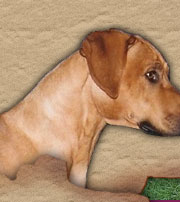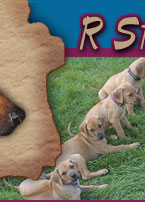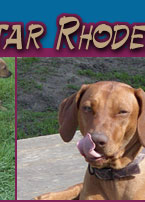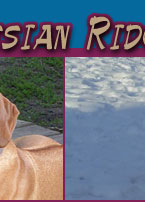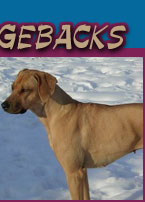Breed
Info
As puppies, Rhodesian Ridgebacks are fun loving, exuberant, inquisitive,
and somewhat rambunctious. A six-month old Ridgeback puppy can unmeaningly
knock over a toddler. A toddler can unmeaningly heap arbitrary punishment
upon a young and impressionable puppy. Therefore, parents should exercise
a great amount of supervision so that neither puppy nor baby inflicts
abuse upon one another. This holds true throughout the preschool age
period of a child and for the first 18 to 24 months of a Ridgeback's
life. Mature Ridgebacks and school age children are best buddies and
friends for life.
The
Ridgeback is not a trouble-maker; however, once attacked or threatened
by another dog, the Ridgeback will stand its ground and fight if
it has to. Most of the time a Ridgeback is only looking for a doggy
pal to play with and does not normally view other dogs as a threat.
However, multiple, intact males around unspayed females can create
some problems. A Ridgeback is very good with cats, but should be
exposed to them when it (the Ridgeback) is young.
As
guard dogs, Ridgebacks use great discretion. They are not frantic
barkers and they are not looking to attack anyone. Usually, they
will give a couple of loud bellows to get your attention and let
you know someone is on the property. They do not bark indiscriminately.
When Ridgebacks bark, they have a good reason to do so but will
usually stop when you tell them -- unless they are certain you are
not aware of what they are trying to tell you. It is always wise
to investigate when Ridgebacks bark. Until you tell them everything
is okay, they will continue to act alert and wary around strangers.
A Ridgeback
should not be trusted to stay within unfenced property boundaries.
They are hounds and have a good nose and excellent vision. Because
of this they will take off, completely forgetting imaginary boundary
lines, if they see something that captures their interest. Fencing
is a must -- a minimum of 5 feet. Young Ridgebacks get bored easily
and they can dig some good-sized holes. If you are going to have
to keep your puppy or young dog alone for hours on end, day after
day, construct a good-sized indoor/outdoor run to keep him out of
boredom mischief.
Because
of his short coat and very little shedding, the Ridgeback stays
clean and odor free. Once a week currycombing, occasional baths,
ear cleaning, and nail trimming are all that is needed to keep him
well groomed and fit to live in your house. Ridgebacks are ``people''
dogs. They like to be where you are, and if you allow it, they'll
crawl into your bed, onto your sofa or favorite chair and your lap.
You have to decide what is acceptable behavior and train them accordingly
at a very early age. They are very easy to housebreak if the owner
is diligent and exercises common sense in the training period. It
is best to limit a young dog to certain areas of your house where
you can keep an eye on him. As older dogs they usually can have
full roam of the house with no problems.
Train
them early to ride in the car. A crate is strongly recommended as
it acts as their seat belt and allows you to open car windows widely
in warm weather. Never leave a dog in the car in hot weather --
even for a short period of time.
It
is rare that a Ridgeback is found to be a fussy eater. If a Ridgeback
suddenly refuses to eat, it is most likely sick and a veterinarian
should be consulted. Their appetites are large, and no matter how
much food you give them, they will try to convince you that it is
not enough. Free feeding is not recommended for a Ridgeback. The
biggest problem with first-time Ridgeback owners is that they allow
their dogs to get too fat. It is best to follow your breeder's advice
to the letter concerning type and quantity of food to feed. Ridgebacks
are inherently adept at stealing food off of table tops -- so stand
warned.
A Ridgeback,
especially a young one, should have a safe place to exercise. This
does not have to be several times a day or even every day. A couple
of times a week to run and stretch muscles and get rid of young-dog
exuberance is usually all that is needed. A brisk walk a few times
a day in combination with periodic high energy runs are all that
is needed for those who do not have the benefit of fenced property
or who live in the city or an apartment.
The Ridgeback represents a strong,
muscular and active dog, symmetrical and balanced in outline. A
mature Ridgeback is a handsome, upstanding and athletic dog, capable
of great endurance with a fair (good) amount of speed. Of even,
dignified temperament, the Ridgeback is devoted and affectionate
to his master, reserved with strangers. The peculiarity of this
breed is the ridge on the back. The ridge must be regarded as the
characteristic feature of the breed. The standard for the Rhodesian
Ridgeback can be found on the Rhodesian
Ridgeback Club of the U.S.
|
